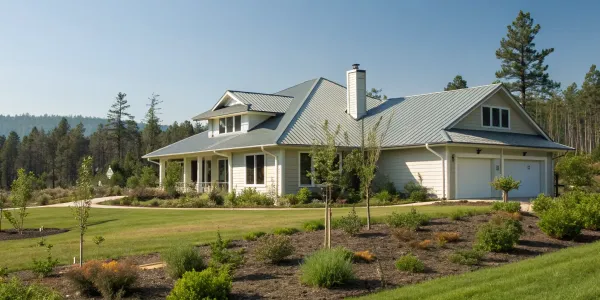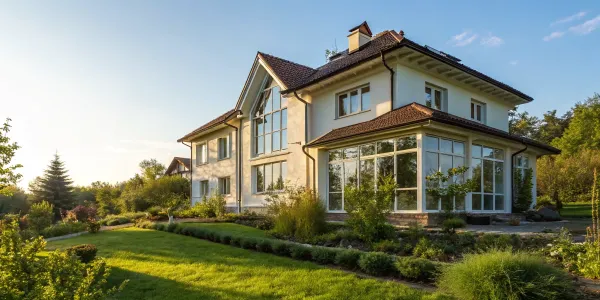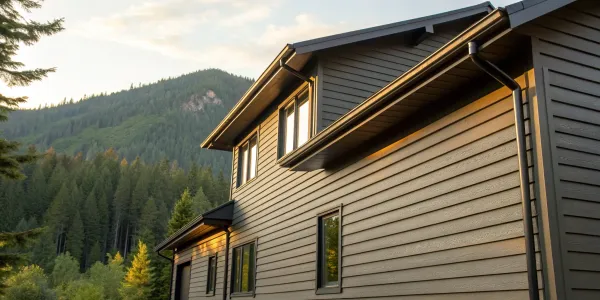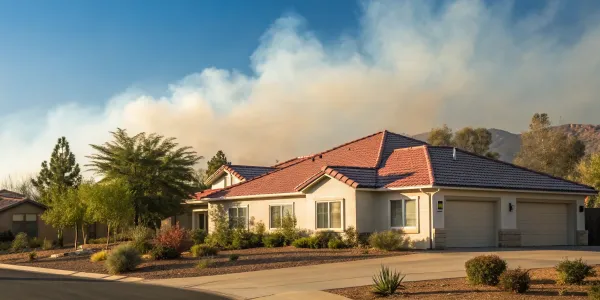Fireproof Home Design: Essential Steps for Resilience
Fireproof home design starts with smart materials, layout, and landscaping. Learn practical steps to create a safer, more resilient home for your family.
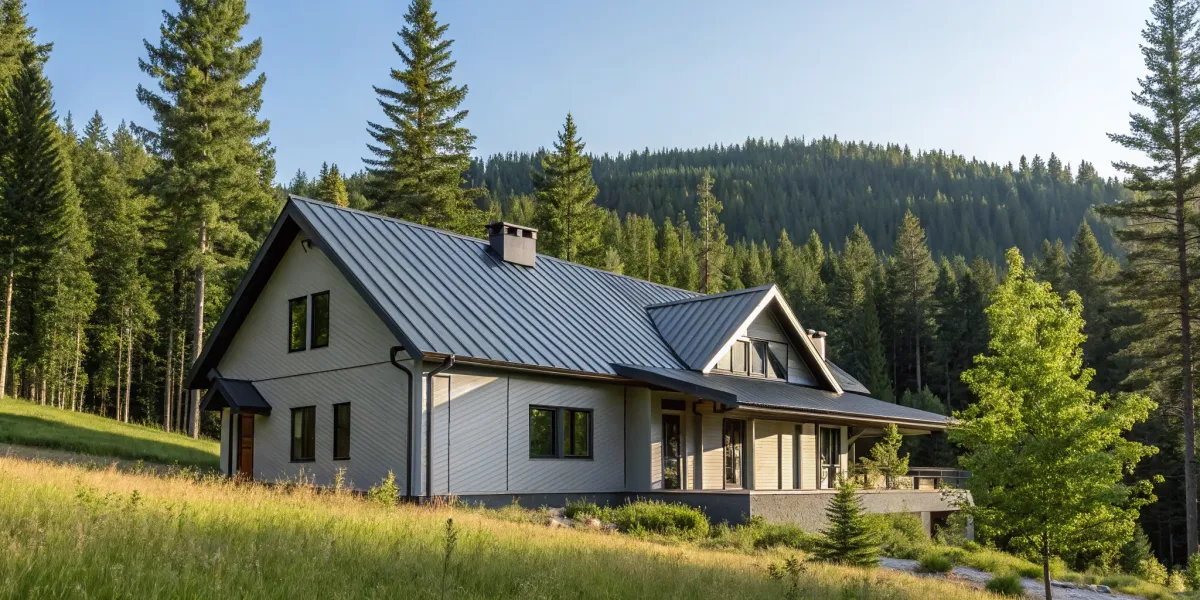
You can’t stop a wildfire from starting, but you can fundamentally change how your home responds to one. Building with fire in mind is an act of empowerment. It’s about shifting your perspective from hoping for the best to preparing for the worst with confidence and intention. Every choice you make in the design process gives you more control over the safety of your family and your property. By focusing on a proactive fireproof home design, you are not just constructing a house; you are building a resilient structure engineered to survive. This guide will give you the actionable knowledge to build a home that actively defends itself.
WiserBuild CTA Button
Key Takeaways
- Harden Your Home from the Outside In: Your home's resilience starts with its structure. Use non-combustible materials for your roof, siding, and windows to build a durable shell that actively repels embers and makes your home a lower risk to insure.
- Design a Smart Defensible Space: The landscape around your home is your first buffer against wildfire. Strategically use hardscaping like gravel paths, select fire-resistant plants, and maintain clear zones to stop a fire before it reaches your house.
- Commit to a Long-Term Safety Plan: Fire resistance isn't a one-time project. A smart interior layout with clear escape routes, combined with a regular maintenance schedule for cleaning gutters and managing vegetation, ensures your home stays protected season after season.
Design a Home That Resists Fire
When you're building or remodeling in a high-risk area, every design choice matters. Thinking about fire resistance from the very beginning isn't just a safety measure—it's a foundational part of creating a resilient, secure, and insurable home. It’s about making intentional decisions that protect your family and your investment. Let's break down what that really means and how you can approach your home's design with confidence.
What "Fire-Resistant" Really Means
First, let's get one thing straight: no home can be 100% fireproof. The goal is to make it fire-resistant. This means using materials and construction techniques that slow the spread of flames, giving your family more time to get out safely. Think of it as building layers of protection into the very structure of your house. Choosing the right fire-resistant building materials is a smart investment in your home's safety and your family's future security. It’s about shifting from a reactive mindset to a proactive one, where your home itself becomes an active part of your defense against wildfire.
Meet Local Building Codes
Building codes aren't just bureaucratic red tape; they are a critical roadmap for safety, especially in wildfire-prone regions. States and local jurisdictions have specific rules for building fire-resistant homes. For example, California has statewide codes that guide builders on everything from roofing and siding to landscaping, all designed to stop fire from spreading. Following these local building codes and working closely with fire safety inspectors is essential. Ensuring your plans are compliant from the start saves you from costly revisions and gives you peace of mind that your home is built to the highest safety standards required for your area.
Lower Your Insurance Risk
A fire-resistant home isn't just safer—it's also more attractive to insurance companies. When insurers see that you've used fire-resistant materials and followed smart design principles, they view your home as a lower risk. This can translate directly into financial benefits for you. Many insurance companies offer discounts for homes with fire-resistant features, making your investment pay off over the long term. Building a resilient home is an investment that offers lasting benefits, from increased safety to potential discounts on home insurance. It’s a practical way to protect your finances while safeguarding your family.
Choose the Right Fire-Resistant Materials
The materials you build with are your home’s first and most important line of defense against a wildfire. Think of your home’s exterior as a protective shell—every component, from the foundation to the rooftop, plays a critical role in its resilience. Choosing the right materials isn't just about meeting code; it's about creating a structure that can actively resist ignition from flying embers and intense heat. These decisions directly influence your home's ability to survive a fire and can also have a significant impact on your insurance options and premiums. A home built with proven, non-combustible materials is simply a better risk, which is something insurers look for.
Fortunately, many of the most fire-resistant materials also offer excellent durability against other harsh weather, like hail, wind, and heavy rain. This means your investment in fire safety doubles as an investment in a long-lasting, low-maintenance home. When you design a fire-resistant house, you’re making smart choices that pay off in both peace of mind and long-term value. It's a proactive approach that moves beyond basic compliance to create genuine security. Let’s walk through the key areas where your material selections matter most, from the walls that surround you to the roof over your head.
Fortify Your Home's Exterior
Your home's exterior walls are its primary shield. To make them as strong as possible, choose non-combustible materials that won’t ignite when exposed to flames or embers. Masonry options like brick, natural stone, manufactured stone, and concrete are excellent choices. They don’t burn, and they create a formidable barrier against heat transfer. These materials also stand up incredibly well to other severe weather, making them a durable and reliable investment for any home in a high-risk area. By focusing on a non-combustible exterior, you significantly reduce the chance of your home catching fire in the first place.
Select a Resilient Roof
Your roof is one of the most vulnerable surfaces during a wildfire because it’s a prime landing spot for airborne embers. That’s why selecting a roof with a high fire-resistance rating is non-negotiable. Look for materials with a ‘Class A’ fire rating, which is the highest level of protection available. Top choices include metal roofing, clay or concrete tiles, and asphalt fiberglass shingles. Metal roofs are particularly effective and durable, often lasting 40 years or more while providing excellent resistance to fire, rain, and snow. A Class A roof is one of the most critical features for protecting your home.
Secure Your Windows and Doors
Windows and doors are potential weak points where fire can penetrate your home. To secure them, install double-glazed windows, which feature two panes of glass. If extreme heat causes the outer pane to crack, the inner pane remains intact, providing a crucial layer of protection. For even greater safety, opt for tempered glass, which is much stronger than standard glass. It’s also wise to choose metal frames over vinyl, as vinyl can melt at high temperatures. Finally, install solid, fire-rated doors, especially for any entrances leading from a garage or deck into your home.
Protect Your Ventilation System
Vents are necessary for airflow, but they can also be an open invitation for embers to enter your attic and crawl spaces. Standard vents with wide openings offer little resistance. Instead, you should install vents specifically designed to block embers. These often feature a fine metal mesh or a baffled design that stops embers while still allowing air to circulate. It’s essential to avoid plastic vents entirely, as they can melt in high heat and create an even larger opening for flames to get inside. This small detail can make a huge difference in keeping your home safe.
Add Interior Safety Features
While a strong exterior is designed to keep fire out, interior safety systems are your backup plan if it ever gets inside. A whole-house sprinkler system is one of the most effective tools for suppressing a fire before it can spread. These systems can extinguish a fire in its earliest stages, often before the fire department even arrives. You should also install smoke detectors in every bedroom, outside each sleeping area, and on every level of the home. Remember to test your smoke detectors regularly and replace the batteries to ensure they’re always ready to alert you.
Plan a Smarter, Safer Layout
Beyond the materials you choose, the very layout of your home plays a critical role in its resilience to fire. A well-designed floor plan can be the difference between a close call and a catastrophe. Think of your home’s blueprint not just as a guide for construction, but as a map for evacuation and defense. By strategically planning room placement, exit routes, and interior barriers, you can create a space that inherently slows the spread of fire and gives your family precious time to get to safety.
This kind of thoughtful design is about more than just meeting minimum code requirements; it’s about building a comprehensive safety system into the structure of your home. When you prioritize flow, access, and containment from the very beginning, you create a safer environment that is also more attractive to insurers. A smart layout works hand-in-hand with fire-resistant materials to form layers of protection, ensuring your home is prepared from the inside out. These are the details that matter most when every second counts.
Consider Your Floor Plan
In an emergency, a clear and simple path to safety is your best asset. Your floor plan should prioritize quick and easy evacuation for everyone in the household. A great starting point is to design multiple exit routes from every single room—ideally, a door and a window. Keep hallways and staircases wide and free of clutter to allow for easy movement. When deciding on room placement, consider putting bedrooms closer to exits on the ground floor. This simple choice can significantly reduce the time it takes to get outside, which is especially important when you’re waking from sleep and need to act fast.
Build Interior Fire Barriers
Containing a fire to its room of origin is a key strategy for minimizing damage and allowing for a safe escape. You can accomplish this by building fire barriers inside your home. Use materials that resist burning to create compartments that slow a fire’s progress. This includes installing fire-resistant drywall (often called Type X) and choosing non-combustible flooring like tile, slate, or concrete. Don’t forget the doors; solid-core wood doors or certified fire-rated interior doors can hold back flames and smoke, buying you critical time to get out. These interior defenses are a powerful way to build resilience into your home’s core.
Integrate Safety Systems
While your home’s structure provides passive protection, active safety systems are your first line of defense. These are the alarms and sprinklers that alert you to danger and begin fighting the fire immediately. A whole-house sprinkler system is one of the most effective safety features you can install, as it can often extinguish a fire long before the fire department arrives. At a minimum, ensure you have interconnected smoke detectors in every bedroom, in the hallways outside sleeping areas, and on every level of the home. The National Fire Protection Association also recommends placing carbon monoxide detectors on each floor to protect against this invisible threat.
Ensure Emergency Access
Your safety plan should extend beyond your front door. First responders need to be able to find and reach your home quickly in an emergency. When planning your site, ensure your driveway is wide enough and has a sufficient vertical clearance to accommodate a large fire truck. Your house number should be clearly visible from the street, even at night, with large, reflective numbers. Keep the driveway and the area around your home clear of obstructions like low-hanging tree branches or parked vehicles that could block access. Making it easy for help to get to you is a simple but vital part of a comprehensive fire safety strategy.
Create a Defensible Space
The structure of your home is just one part of the equation; what surrounds it matters just as much. A defensible space is a buffer you create between your house and the surrounding vegetation. Think of it as a protective bubble that can slow or even stop a wildfire from reaching your front door. It gives firefighters a safer area to work in and dramatically increases your home’s chances of survival. This isn’t about clear-cutting your property; it’s about smart, strategic landscaping that actively defends your home.
Implement the Three-Zone Strategy
The best way to approach this is with a three-zone strategy. Zone 1 is the area immediately around your home (about 0-5 feet), where you should use non-combustible materials like gravel or pavers. Zone 2 (5-30 feet) is for low-growing, well-irrigated plants, with trees spaced far apart. Zone 3 (30-100 feet) is a transition area where you thin out vegetation and remove dead material. The goal of creating defensible space is to break up the path of a fire. By carefully placing trees and grouping shrubs outside the immediate zone, you disrupt the fuel source and prevent flames from easily spreading from the wildland to your home.
Select Fire-Resistant Plants
Let’s clear up a common myth: fire-resistant landscaping doesn’t have to be a barren rock garden. In fact, a well-maintained landscape with the right plants is much safer than dry, neglected land. The key is choosing plants that are less likely to ignite and burn. These plants typically have supple leaves, high moisture content, and a low sap or resin content. You can find many beautiful fire-resistant plants that add color and texture to your yard without adding risk. Think of options like lavender, sage, or succulents. They can enhance your home’s curb appeal while serving as a critical line of defense.
Avoid Common Landscaping Mistakes
Creating a truly effective defensible space means steering clear of a few pitfalls. One of the most frequent common landscaping mistakes is planting tall trees or shrubs in Zone 1, right next to the house. This can act as a ladder, allowing fire to climb from the ground to your roof. Another error is assuming that drought-tolerant plants are automatically fire-resistant—they aren't always the same thing. It's also important to strictly adhere to your designated zones and not let them blend together. Proper spacing and plant selection are what make the system work, so be intentional with every choice you make in your yard.
Commit to Regular Maintenance
Your defensible space isn't a "set it and forget it" project. Regular maintenance is absolutely essential to keep it effective year after year. This means consistently clearing away dead leaves, pine needles, and dry branches from your yard, roof, and gutters, as these materials are kindling for embers. You should also keep your lawn mowed and watered, and prune trees to keep branches at least 10 feet away from your chimney and roof. To further contain any potential flames, consider using non-burnable materials like stone or brick to create borders for your planted beds. This ongoing commitment is what keeps your home protected through every fire season.
Use Fire-Smart Landscaping Materials
The materials you choose for your yard play a huge role in your home's defense against wildfire. Think of your landscaping not just as decoration, but as a functional part of your home’s safety system. By selecting the right materials and arranging them strategically, you can create a landscape that helps slow or stop the spread of flames instead of fueling them. This approach is about creating intentional breaks in flammable vegetation and using non-combustible materials to build a protective buffer around your home. These smart landscaping choices are a critical component of a resilient design and can make your property more appealing to insurance providers.
Use Non-Combustible Ground Covers
One of the most effective ways to create a fire-resistant yard is to replace flammable ground covers like bark mulch with non-combustible alternatives, especially within the first five feet of your home. Materials like gravel, pavers, decomposed granite, and concrete act as a firebreak, preventing ground fires from reaching your exterior walls. These covers don't ignite easily and can stop embers from finding a place to smolder. Using these non-combustible materials to create walkways or surround planting beds also helps break up the continuity of vegetation, making it harder for fire to travel across your property.
Add Hardscaping Elements
Hardscaping is your best friend when designing a fire-smart landscape. Features like stone retaining walls, concrete patios, and brick walkways serve as excellent fuel breaks that can halt the advance of a fire. By incorporating these elements, you can create beautiful, functional outdoor living spaces that double as strategic fire defenses. A well-placed patio can separate your lawn from your house, while a stone wall can stop a ground fire from climbing a slope. These hardscape features are a permanent, low-maintenance way to reduce the amount of flammable vegetation in your yard and build a more resilient defensible space.
Manage Trees and Shrubs Wisely
While plants are a beautiful part of any landscape, they are also fuel for a fire. It’s essential to manage them carefully. Start by removing any dead or dying trees and shrubs, and prune branches that overhang your roof or come too close to the chimney. When planting new vegetation, properly space your plants to prevent them from forming a continuous canopy that fire can easily travel through. Grouping plants into "islands" separated by non-combustible hardscaping or irrigated lawn can also help slow a fire's spread. This thoughtful arrangement turns your plants into assets rather than liabilities.
Plan for Irrigation and Water Features
A well-hydrated landscape is less likely to ignite. A properly designed and maintained irrigation system is key to keeping your plants healthy and fire-resistant, especially during dry seasons. Consider using drip irrigation or soaker hoses to deliver water directly to the roots, which is more efficient and helps maintain soil moisture. Beyond standard irrigation, water features like pools, ponds, or even a simple fountain can act as natural firebreaks. They create a humid microclimate and serve as an emergency water source for firefighters, adding another layer of protection to your home’s defensible space.
Keep Your Home Protected
Building a fire-resistant home is a huge accomplishment, but the work doesn’t stop once construction is complete. Just like any other part of your home, your fire-resistant features require ongoing attention to stay effective. Think of it as protecting your investment. Over time, materials can wear down, vegetation can overgrow, and even small issues can create new vulnerabilities. Consistent upkeep is what ensures your home remains a safe haven for years to come.
Creating a maintenance plan might sound like a chore, but it’s one of the most powerful things you can do to maintain your home’s resilience. By breaking down tasks into a manageable schedule, you can stay ahead of potential problems and keep your property in top condition. Regular inspections, critical cleaning tasks, and periodic professional assessments all work together to preserve the safety features you so carefully designed and built. This proactive approach not only gives you peace of mind but also helps ensure your home remains compliant and insurable.
Follow a Regular Inspection Schedule
The best way to stay on top of home maintenance is to make it a routine. A regular inspection schedule helps you catch potential fire hazards before they become serious threats. You don’t need to be an expert to do this—it’s more about being observant and consistent. Create a simple checklist and set reminders on your calendar for seasonal walk-arounds. In the spring, check for any damage that winter storms may have caused. In the fall, focus on clearing away dry leaves and debris. Regular home maintenance keeps your home’s defenses strong year-round, ensuring that all your fire-safe measures are ready when you need them most.
Know Your Critical Maintenance Tasks
Certain tasks are non-negotiable for keeping a fire-resistant home safe. At the top of the list is cleaning your gutters and roof regularly. Dry leaves, pine needles, and twigs are perfect tinder for embers, and keeping these areas clear removes a major fire risk. You should also inspect your roof and siding at least once a year for any cracks, gaps, or damage. Finally, keep your landscaping trimmed, especially within the first five feet of your home. Removing dead branches and keeping plants pruned reduces the fuel available to a fire, which is a critical part of maintaining your defensible space.
Keep Your Systems Updated
Your home’s fire resistance depends on its materials and systems working correctly. It’s important to regularly check that your fireproofing materials are in good condition and haven’t been compromised by weather or wear. This includes checking seals around windows and doors and ensuring vents are clear and properly screened. It’s also smart to stay aware of local fire safety rules, as codes can be updated over time. Making sure your home continues to meet all local requirements is essential for both safety and compliance. A small repair or update today can prevent a major failure during a fire.
Schedule a Professional Assessment
While your own inspections are vital, there’s no substitute for a professional eye. Periodically scheduling an assessment with a fire safety inspector or a qualified contractor can provide invaluable insights. These experts are trained to spot vulnerabilities you might overlook and can offer recommendations tailored to your specific property. If you’re building or renovating, it’s especially important to work with inspectors during the process to address any concerns early on. A professional review gives you confidence that your home is as safe as it can be and helps ensure it meets the standards that insurers look for.
Related Articles
- Wildfire Resilient Homes & Building Code Compliance
- Wildfire Resilient Homes & Building Code Compliance
- Wildfire Resilient Homes & Building Code Compliance
- Wildfire Resilient Homes & Building Code Compliance
- Wildfire Resilient Homes & Building Code Compliance
WiserBuild CTA Button
Frequently Asked Questions
If my budget is limited, what are the most important fire-resistance upgrades to make? If you have to prioritize, focus on the two most vulnerable areas: your roof and the space immediately surrounding your home. Your roof is a prime target for flying embers, so investing in a Class A-rated material like metal or tile makes a huge difference. Equally important is creating a non-combustible zone in the first five feet around your foundation using materials like gravel or pavers. These two steps alone can dramatically reduce the chance of your home igniting.
Does making my home fire-resistant mean it has to look like a concrete bunker? Not at all. Modern fire-resistant design offers a wide range of beautiful and stylish options. Materials like natural stone, brick, and stucco for siding create a classic and durable exterior. Metal roofing now comes in various styles and colors that can complement any architectural design, from traditional to contemporary. You can absolutely build a warm, inviting, and aesthetically pleasing home that is also incredibly resilient.
I'm remodeling an older home, not building a new one. Can I still apply these principles? Yes, absolutely. While it’s easiest to incorporate these features from the ground up, many critical upgrades can be made during a renovation. You can replace an old roof with a Class A-rated one, swap out old windows for double-glazed versions, and install ember-resistant vents. Landscaping and creating a defensible space are also projects you can tackle at any time. Every improvement you make contributes to your home's overall safety.
Will making all these changes guarantee I can get or keep my home insurance? While there are no absolute guarantees in the insurance world, taking these steps makes your home a much lower risk and therefore far more attractive to insurers. Companies are looking for homeowners who are proactive about mitigating risk. By using fire-resistant materials, maintaining a defensible space, and ensuring your plans meet code, you are demonstrating that your property is a responsible and defensible investment, which can significantly improve your ability to secure and maintain coverage.
What is the single biggest mistake homeowners make when creating a defensible space? The most common and dangerous mistake is planting flammable vegetation right next to the house. Placing large shrubs or trees within the first five feet of your home’s foundation creates a "ladder" for fire. Flames can climb these plants and easily reach your siding, eaves, or roof. Keeping this immediate zone clear of anything combustible is one of the most effective strategies for protecting your home.

